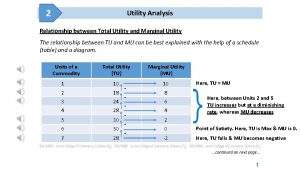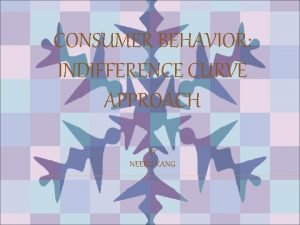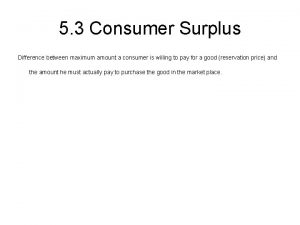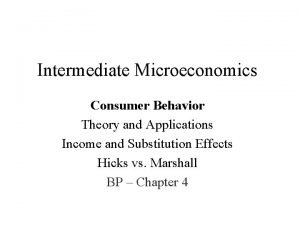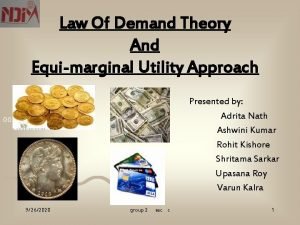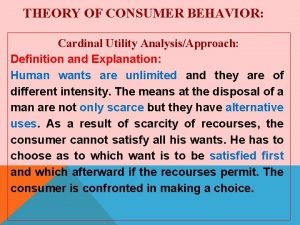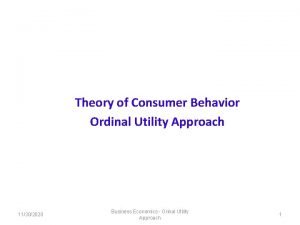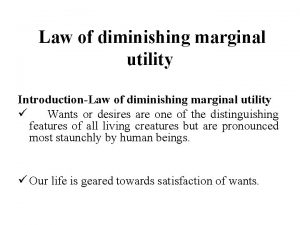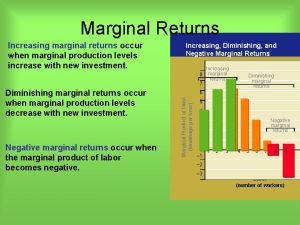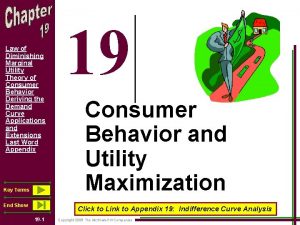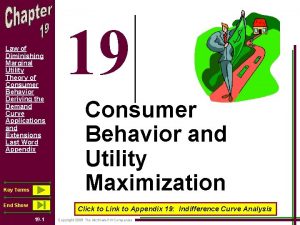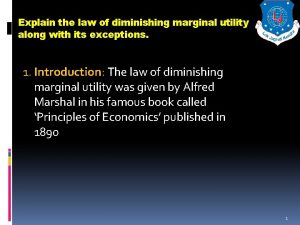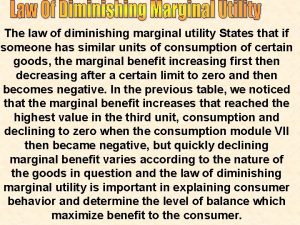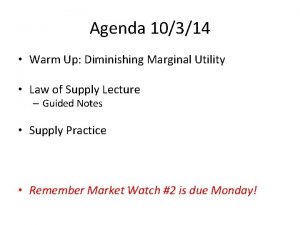Today n Utility n n Diminishing Marginal Utility


















- Slides: 18

Today n Utility n n Diminishing Marginal Utility How to Max. Utility Consumer’s Surplus Read Chapter 19, skip appendix.

Where does a household’s demand curve come from?

Consumer Choice n n Utility: An abstract concept used to describe well-being or satisfaction. Consumer’s Goal: to maximize utility, subject to available income.

A Simple Approach n Assume utility can be quantified. n n n A person can measure his utility. Each person’s “scale” is different. As consumption increases, total utility increases.

Diminishing Marginal Utility n n Marginal Utility: The additional utility one gets from consuming one more unit of a good. We assume consumers get diminishing marginal utility as their consumption of a good increases.

Example: Eating Pizza n The second slice of pizza doesn’t increase your utility as much as the first one did. Units of utility/slice 1 2 3 4 5 Slices/day

Your MU in $ Spent on Pizza n n Now measure a unit of utility in dollar terms. The vertical scale changes, but $/slice still goes down for each unit. Value in $/slice $5 4 3 2 1 1 2 3 4 slices/day

Your Demand Curve for Pizza n The height of an individual’s demand curve represents the most he is willing to pay to get each successive slice of pizza. Value in $/slice $5 4 3 2 1 1 2 3 4 D slices/day

Total Value to Consumer n The area under a demand curve represents the total value to the consumer of consuming a particular Q of a good.

Total Valuation n $/unit 8 n 6 This consumer is willing to pay $9 for one unit. Or $42 for 7 units. 4 2 D 1 2 3 4 5 6 7 units

Utility Maximization n $/unit 8 6 n 4 2 n D 1 2 3 4 5 6 7 units The consumer maximizes utility by consuming until his marginal valuation is equal to the price. If P=$6, he buys 4 units are worth $30 to him.

Utility Maximization n The 3 rd unit is worth $7 to him, costs only $6. Can increase utility by buying more. The 4 th unit is worth exactly $6 to him. Assume he goes ahead. The 5 th unit is worth $5, but costs $6. Stop at 4 units.

Consumer’s Surplus n n n The 4 units cost him 4@$6 = $24. They are worth $30 to him. The difference is called his “consumer’s surplus”.

Consumer’s Surplus n Consumer’s Surplus: the difference between how much a consumer values a good and how much he pays for it.

Graph of CS n $/unit n 8 n 6 4 2 D 1 2 3 4 5 6 7 units CS = $6 when the price is $6. No CS is earned on the 4 th unit. CS is the area under D and above P.

Smooth Graph of CS n $/unit n 8 A n 6 4 B D 2 1 2 3 4 5 6 7 units A+B = the value to the consumer from 4 units. B = what the consumer pays for those 4 units A = Consumer’s surplus from the 4 units.

Coming Up n n Application of consumer’s surplus. Getting a market demand curve from individual demand curves.

Now n Go over exams.
 Diminishing marginal utility
Diminishing marginal utility Diminishing marginal utility
Diminishing marginal utility Relation between marginal utility and total utility
Relation between marginal utility and total utility The law of diminishing marginal rate of substitution
The law of diminishing marginal rate of substitution Marginal productivity formula
Marginal productivity formula Marginal rate of technical substitution
Marginal rate of technical substitution 24 18
24 18 Diminishing mrs
Diminishing mrs Rumus marginal utility
Rumus marginal utility Law of equi marginal utility
Law of equi marginal utility Law of equi marginal utility
Law of equi marginal utility Normal or inferior good
Normal or inferior good Equalizing marginal utility per dollar
Equalizing marginal utility per dollar Law of equi marginal utility
Law of equi marginal utility Cardinal utility approach
Cardinal utility approach Todaysclass
Todaysclass Today's lesson or today lesson
Today's lesson or today lesson Today meeting or today's meeting
Today meeting or today's meeting Characteristic of fingerprint
Characteristic of fingerprint


